Scooter Kitten
The words of a girl exploring the world, sometimes on the back of a Vino.
Tuesday, April 24, 2012
Construction Zone
I've decided to switch my blog up now that Blogger is offering new design options for its blogs. I'm hoping to soon add city guides for those places I've visited that were scooter friendly along with maps and route conditions, which I thought might be more helpful content for your fellow scooter riders out there. Let me know what you think and feel free to add a place you think might be worthy of a visit by scooterkitten.
Friday, September 24, 2010
MINI to manufacture scooters

For those of you who don't know me well, I used to be a VW girl. Well, I really still am. But I prefer the old Beetles. Unfortunately I had to give up my bug Gilbert because I didn't have the money to continuously pour into him to keep him in working condition, and without the tools to fix him myself it was a challenge to find someone around my town who could. (Let's face it, old cars require real know-how that can't be taught at mechanics' school.)
A few years back I found Gilbert a new home and settled on a Mini Cooper. I love Mini. They might not be as ecologically friendly as the Smart car, but they are one step above almost everyone else. (Subaru is tops in America I hear. But Mini is tops in England.)
Today as I was writing up an SEO article for extra bucks, (I would never do it full time as a career unless I was desperate. It's selling out.) I came across this article about Mini announcing a new line of scooters to be sold in France in competition with Smart's E-scooter, or electric scooter.
I have to say, they look pretty slick. Much slicker than the traditional Vespa. I'd totally fall for one of these if they were available in America. But that's always the trick, huh. We seem to lead the world in tawdry Hollywood stories and great music, but we are somehow behind in the automotive industry. Especially if it means a non-gas powered vehicle.
While these are just concept vehicles right now, I could totally get behind one. I just wouldn't want one with those stupid U-shaped visors that cover the top. (Check out the photo on the right of the article page.) Though I guess it would be good if you plan to just scoot in all weather.
Hmmm, now there's a thought.
Sunday, June 6, 2010
Living without a car
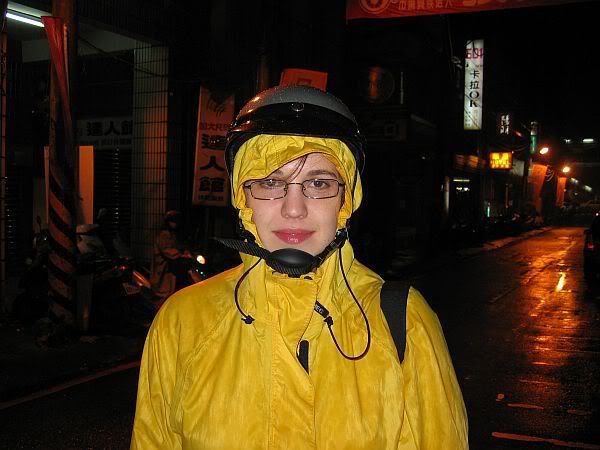 At left, Steph ready for a scooter ride in the rain by Abbysmal from Photobucket.
At left, Steph ready for a scooter ride in the rain by Abbysmal from Photobucket.One broken wheel and a busy week later and I'm wondering if my past desire to only drive a scooter is a realistic one.
I had taken my Mini Cooper to a local tire dealer who at first ordered the wrong tires, then somehow broke my wheel. Yes, broke my wheel.
They had to special order the wheel, and when it finally came in three days later, it was the wrong wheel. This left me more than a week without a car as my poor Mini languished in a strip mall parking lot. (I won't get into my freak-out when a hail storm hit the area and I thought they'd left my baby outside.)
I learned that if I really want a scooter to travel around on a regular basis, I'm probably better off with a 150cc powered one or higher. I love my 125 Vino, but I couldn't go home to visit friends and family over Memorial Day weekend because it just wasn't safe to travel Route 422 on it. I would've been moving much too slow for the traffic and likely would've gotten blown off an overpass by a semi.
The scooter even proved itself a little impractical for running errands around town. I couldn't fit a full load of groceries in the storage compartment, and I don't have the proper ties or cargo holder to carry stuff on the cargo bar. Of course if I did, it probaby wouldn't have been so bad.
Then there is the matter of rain. It turned out to be a pretty wet week, which kept me inside when I wanted to travel to do something. I have a rain suit for hiking, which would have worked fine for the scooter. It's bright yellow and made by Columbia Sportswear.
I don't have a windscreen, which means even with a full-face helmet, I can find myself riding in the rain and feeling like someone is shooting bullets at me. And forget about going out with the half-face and getting stuck in a storm. Miserable experience. Happened twice.
So is it practical to only have a scooter for a vehicle? Well, if you don't have to travel on major highways to get anywhere, have the right equipment, and don't mind driving in the rain, I guess so, but it wouldn't be easy. I guess that's why most populations that use mostly scooters live in warm, tropical places or major cities. You don't have to travel far when you carry something and home is not too far away when it rains. If it rains.
Tuesday, June 1, 2010
My fear of hitting living things
 It's a beautiful day. You are riding down a shade-dappled road with the windows open and the music on.
It's a beautiful day. You are riding down a shade-dappled road with the windows open and the music on.It's the perfect temperature. Things are going well at work and at home. Life is great.
Then some poor woodland creature ventures out onto the pavement in front of you and bam, you see the critter too late and hit it. Horrible.
Bird photo by Amyjane10/Photobucket
It's a scenario I've tried avoiding. To my passengers' dismay I'd rather slam on my brakes or swerve than barrel through any living thing, even butterflies. (Especially butterflies. So few species of them have a fighting chance anymore.)
Thankfully I've only hit one creature in my lifetime and it was a rabbit that ran under my wheels.
But I've noticed that driving on the country roads that I prefer puts me in more danger of a collision with animals than I'd like.
Of particular concern to me are birds who tend to dart out in front of me as I drive by, likely because they are suddenly scared by my quiet engine. I'm worried about what happens if I hit one of them.
It's not going to collide with my hood or windshield. I don't have a windshield. What's going to hit that poor bird is me: my helmet or my body.
A windscreen is already on my list of must-haves for the scooter, but I don't know if that will make it any better. I'm that much closer to the poor dying creature and trying not to flip over my bike.
My boyfriend says birds have "bounced" off him before. I don't know if that means they were OK afterwards but I wouldn't be. I think I'd have to pull over because I'd be bawling.
Luckily swerving is easier on a scooter, but hitting something could cause me to have a serious accident.
I just hope the deer stay out of my way.
Thursday, May 20, 2010
Wheelie good fun in Ocracoke
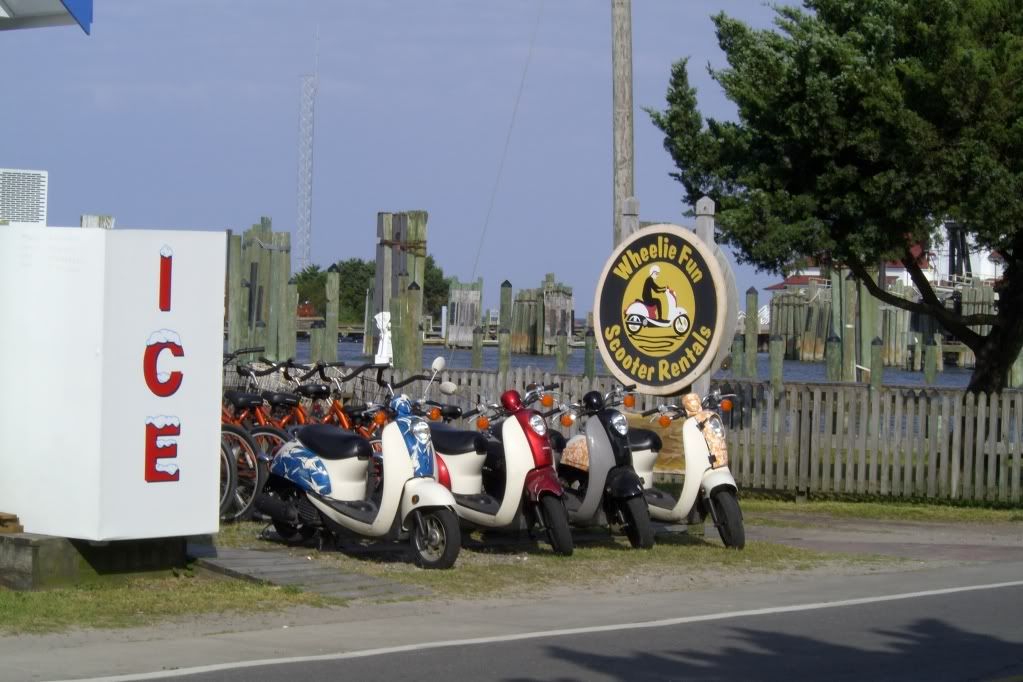
There is an island halfway between Key West and Nantucket in nature and atmosphere.
Ocracoke on the Outer Banks is still truly an island. Unlike Hatteras or the other islands, it can only be reached by ferry, and there isn't a whole lot of land to go around.
Only 14 miles long, it was mostly sandbar except for its southern point until the Park Service tried to save its beaches by constructing giant dunes. The Park Service took over most of the island when the Cape Hatteras National Seashore was created in the 1930s, though the island is in a completely different county in N. Carolina than the islands above it or below it. (In fact it is the richest town in its county, but the people are bitter because they pay the highest taxes than any other residents and get few to no services. Hey, they're an island. It's hard to get basics like trash pickup. It has to all go to or come from the mainland.)
We went at the end of the off season, which was good for us since we hadn't reserved anything. The island has only 800 year round residents, but a lot of rental houses and hotels that fill up quickly during the summer. It's best to reserve ahead of time if you plan to visit between Memorial Day and Labor Day, or you'll find yourself stuck.
They have a National Park Visitor's Center that can help you with everything (the park service workers are all locals so they know the place intimately). They also offer tours about shipwrecks, the lighthouse, pirates and more for free. The Park Service visitor's center is in the village next to the Coast Guard Station and ferry docks. The Coast Guard Station, is no longer in active use since 1996.
The locals consider the tourist draw a blessing and a curse. Many work two to three jobs during the summer and take off for the winter season. But those jobs help them keep their homes, which many have been priced out of in the recent land speculation that caused the housing bubble.
Even today many houses are listed around half a million. (But if you don't mind buying a house to fix up, the Ocracoke Conservation Association is selling two historic houses for around $200,000. Cheap by island standards.)
So what does this have to do with scooters?
Well, the streets are narrow and many aren't paved (they're sand with oyster shells), but scooters are a great way to get around. The business and residential area is 1,000 acres and not all of it can be fully developed (there isn't enough potable water).
So you don't really need a car to get around unless you are carting something. Most of the hotels rent bicycles, but there is a shop at the pier next to SMacNally's that rents scooters called "Wheelie Fun". It did look like someone had been driving them drunk. The front fenders were all bent and cracked. They use Honda Metropolitans.
I did see other people with tricked out scooters who must live or work there because they had meaty jams and were stylin some pretty fancy paint.
We didn't go for the scooters to get around on simply because they were expensive. (Nothing there is cheap because it all has to be shipped in.) They ran about $30 an hour. Yes, an hour.
When you are staying for a while (we were there about a week) I'd opt for the bicycle rentals at the Pony Island Hotel. It's one of the older hotels on the island and is on Route 12, which becomes the main street running through town to the harbor and ferry. Those rentals only cost $2 an hour and you could rent them for $30 for the week.

Cars are a pain on an island that small. There really is no place to turn around, the speed limit is 25 mph or less (there are people EVERYWHERE so you really have to be careful driving through town).
We rented the bikes for one day, after we got rained out of our tent and stayed at the Pony Island (Nice hotel, cheap rooms, owned by a local. Not all hotels on the island are.). It was great to leisurely ride around and not worry about parking. People don't care that you park your bike someplace but good luck finding someplace legal to park your car.
A lot of people use golf carts as well, but there's something so vacationy about riding your bike, and it's the preferred choice of islanders. (There was only one gas station, but they took it out to upgrade it and might be out all summer. You only can get gas after a ferry ride to either Hatteras or the mainland now. They warn you at the ferry to make sure you have a full tank before you get on for Ocracoke.)
Many may say there is little to do on the island. It was a fishing port and entrepot. Ocracoke, and it's neighboring island, Portsmouth (now a ghost town), were founded by an act of the state Legislature after they had too many shipwrecks from vessels trying to get through the inlet into Pamlico Sound. Even today you'd better know the area before you go sailing. The sandbars like to shift around.
 An entrepot is a harbor where large vessels dock and transfer their cargo to smaller ships to get it through shallow waters to mainland towns. Portsmouth was a popular, populated seaport in the 1700s and 1800s until new inlets farther up the Outer Banks opened up after hurricanes in the late 1800s, early 1900s. The shipping traffic went north, leaving the island towns with only fishing opportunities, but those soon died out as new, faster ways to catch fish and get it to market cheaper took over. Ocracoke first started as Pilot Town, which was located around Teach's Hole, a small sound east of the current village.
An entrepot is a harbor where large vessels dock and transfer their cargo to smaller ships to get it through shallow waters to mainland towns. Portsmouth was a popular, populated seaport in the 1700s and 1800s until new inlets farther up the Outer Banks opened up after hurricanes in the late 1800s, early 1900s. The shipping traffic went north, leaving the island towns with only fishing opportunities, but those soon died out as new, faster ways to catch fish and get it to market cheaper took over. Ocracoke first started as Pilot Town, which was located around Teach's Hole, a small sound east of the current village.
(A view of Teach's Hole, though it would have looked much different in the early 1700s when Teach put in there to party with his crew.)
The area once occupied by Pilot Town is now called Springer's Point and it is a preserved area for birds. There is a footpath you can take down to the "hole." and it gets pretty creepy. Some of the island's oldest trees are there and there are still graves, old graves, hidden in the underbrush off the path (don't go looking for them, it's discouraged) and there are old rain cisterns from the houses that used to be there still in the area. The townsfolk believe it to be one of the oldest, most haunted places on the island.
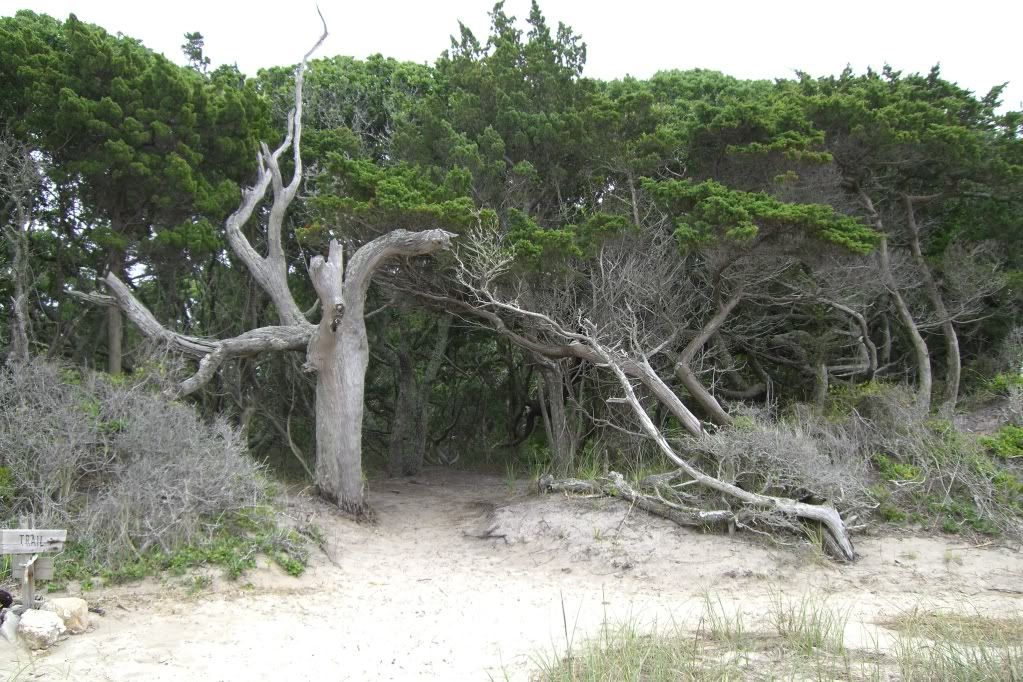
Many of the families that lived on the Point were called pointers and the other half of the islanders were called Creekers. It wasn't until the Coast Guard came and filled in the tidal creeks that separated the islanders and built a road that everyone began living near the harbor. (If the bugs on Portsmouth were any explanation, I know why they stayed away from the marshy harbor. Painful biting flies.)
Our walk to the point was quite cool yet eerie. There is a nature tour with little plaques along the way explaining the local flora, and it's a sandy trail until you get to the highest point of the island which has a large, old oak tree on it, and then you see a grave site. It's the grave of Sam Jones, who had two wives and owned the point, but was buried with his favorite horse Ike. Sam was a transplant who built two of the biggest houses on the island at the time. One is still called the mansion. But he lived on the point.
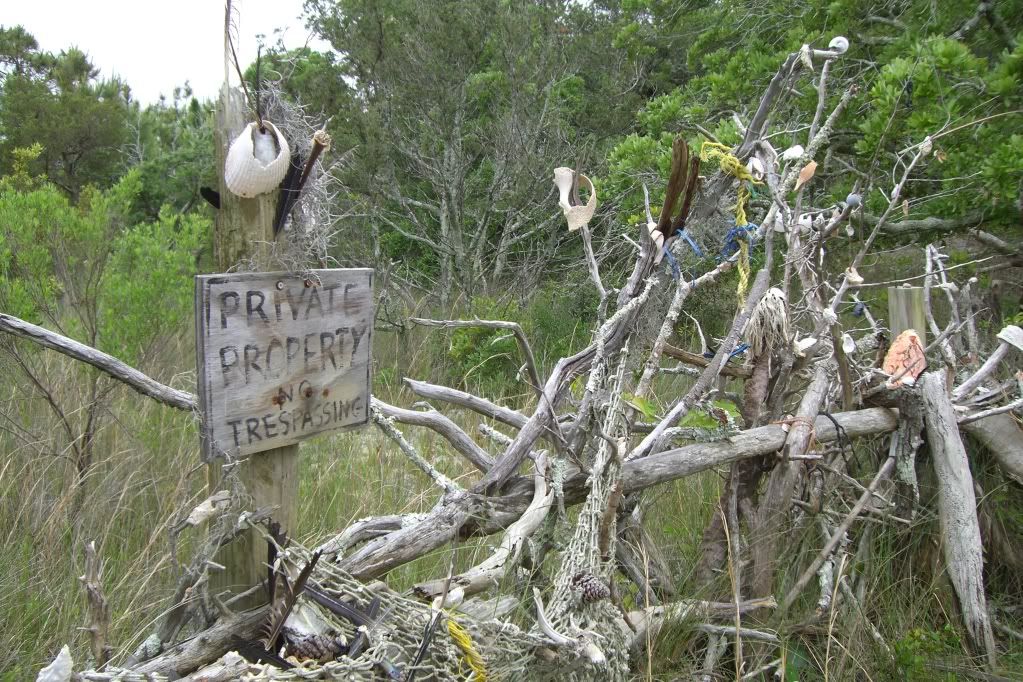
We took a ghost tour and the guide, the last of the Howard family, directly related to the first owner of the island, William Howard, who is thought to be the same William Howard who served as Blackbeard's Quartermaster before Blackbeard was killed on the island, told us that one of Sam's friends saw quite a frightening sight when he went to visit Sam's grave and clean up the area one night. Apparently it was his habit to go and keep the point in shape before it became a protected area. Kids used to go out there and drink. So this friend, Roy, took his boat around to Teach's Hole and came in on the path from the beach. (Seen in the picture above.)
As he came down the shadowy path, he saw a man sitting on the old cistern opposite Sam's grave. This man seemed funny to Roy and was dressed in old-fashioned clothing. Roy stopped and felt odd, so he decided to head back to the beach. As he started walking he heard someone behind him. When he turned around he saw the man on the cistern was coming up the path after him.
Roy began to run at this point, and when he got out to the beach, he jumped in his boat and started paddling. When he turned around he saw the man come out on the beach and walk into the water, and then he dissipated into mist.
 The ghost tour really was worth staying for and we did, spending our last night in a campground at the very first store in town, where the gas pumps were. We would've stayed again at the Pony Island but they were booked up for a wedding. Odd thing is the next morning, we decided to go out to the beach one last time, and as Ed flew his kite, what happens but a wedding party comes on to the beach and got married.
The ghost tour really was worth staying for and we did, spending our last night in a campground at the very first store in town, where the gas pumps were. We would've stayed again at the Pony Island but they were booked up for a wedding. Odd thing is the next morning, we decided to go out to the beach one last time, and as Ed flew his kite, what happens but a wedding party comes on to the beach and got married.Then, when Ed and I went into the water and were getting ridiculously tumbled around by the rough waves, they decided to move down to where we were and take pictures. I guarantee there is a shot with Ed and I being dragged down by the waves with weird looks on our faces in those wedding photos.
There are several places and activities I highly recommend to anyone interested in going to Ocracoke. You can, of course, go surfing, parasailing, or kayaking, renting equipment or buying lessons at one of the surf shops downtown. But you can also head out to Portsmouth Island, which we did. We took the boat tour on the dock next to Kitty Hawk Kites. There are several of these stores the length of the Outer Banks, and they have some pretty cool stuff.
They really want you to reserve for these boat rides and they need at least 3 people to go to the island because of the cost of the fuel. It runs $20 a person, but the captain will also take you past any site in the area you want to see. He took us around to Beacon Island, which once house a fort and a lighthouse before it was consumed by the waves. Oddly the sandbar that is left was visible and above water when we drove by, which Capt. Ron said was really unusual. He'd never seen it.
The island is interesting. The houses are kept in good shape by the Park Service and there are displays in some of them. I don't advise walking off the main path. We made the mistake of going to the school house and were subsequently attacked by swarms of yellow and black biting flies. (I'm still suffering from itchy bites a week later. We had bug spray and it did nothing. But they don't follow you into the houses. We don't know why.)
We ended up running down a forested path thinking we could get away from them. (The other paths through the village are flooded by the tides and you will see little holes in the sand made by little ghost crabs. I saw one scurrying away from me into the marsh. The marsh is also full of baby fish.)
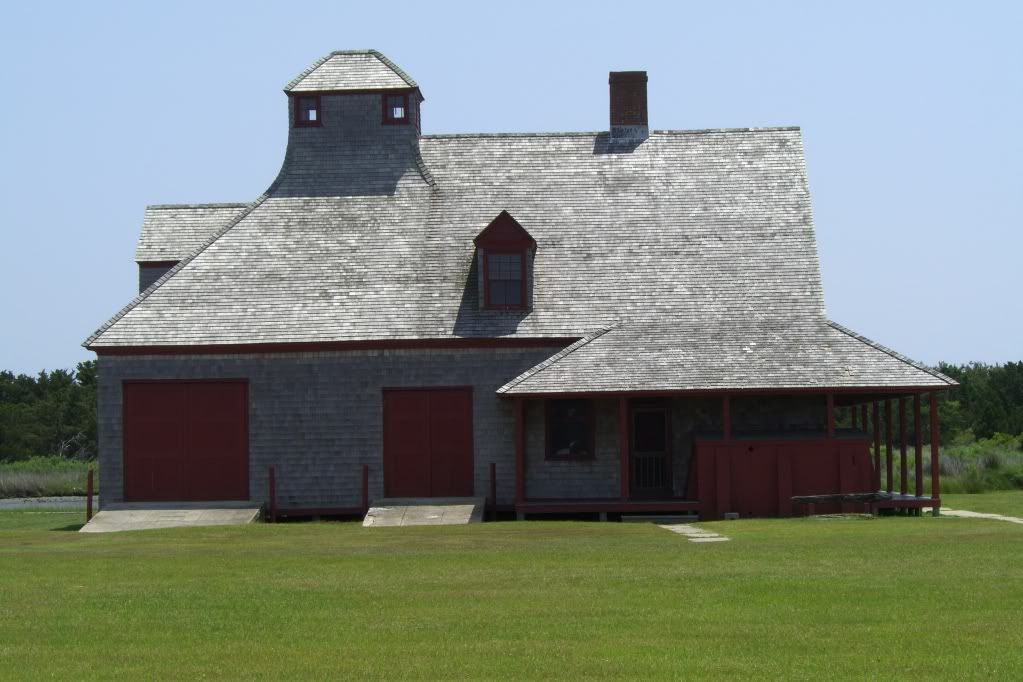
Unfortunately the flies followed us all the way to the old grass airstrip, and we were beating ourselves senseless with our hats trying to get them all off. The only park ranger on the island came riding by on an ATV and waved as we went running past screaming. Some help he was.
The life saving station is quite neat, and you can climb up to the tower and look out to Ocracoke.
We headed for the beach after leaving it hoping to get rid of the flies. Eventually we reached a wide, flat sandy area with strong ocean winds that swept the flies away. But it was a long walk around to the pickup point for our boat.

If you want to find some really awesome shells, I highly recommend heading straight for Portsmouth's beach. It's known for what washes up on it's shore: large, complete shells. Don't waste your money buying them in tourist shops. Go to Portsmouth. You can find some beautiful shells to make jewelry out of with naturally bored holes in them. Some looked like gold.
The first thing I found on the beach, which is about two miles from dunes to the sea, was half a sand dollar. Then I found a perfect one next to it. It had purple spots on the back and looked awesome, but it broke in my hand when I picked up another shell.
I wanted to look for more, but Ed was so worried about missing the boat we rushed down the beach to the pick up spot.
The beach is a real lesson in tidal islands. There are tidal pools where the birds hovered around to eat the small fish that had recently hatched. When the beach floods again the fish will be swept out to sea where they will grow larger.
The sand was carved into strange patterns by the winds and waves, and there were shell "pools" all up and down the beach.

I also recommend hanging out at SMacNally's marina on Silver Lake, which is the name of the harbor in the middle of town. You can get great burgers or seafood there and watch the boats come and cut up their fish. It's not fancy, but it's good.
I also recommend Diajio, which is down the street and has a great bar opening onto a courtyard with trees and tropical plants overshadowing it.
Then there is Zillie's, which is the local wine bar on Back Road which offers a 5 for $15 wine tasting Wednesday's at 6 p.m. They ask you reserve. We showed up but just bought a bottle of wine and hung out on their balcony. The building is three stories and has porches on the second and third floors with brushed metal tables that are great to hang out at. We met a nice couple from Chicago who'd been going to Ocracoke every spring for 10 years. They recommended the ghost tour that leaves from the Village Craftsman shop on Howard Street.
We also loved the coffee shop on Back Road, but there is also a great pastry shop on the main street as well.
The park service campground is the cheapest, but there are two others on the island, one off Back Road and the one off the main street.
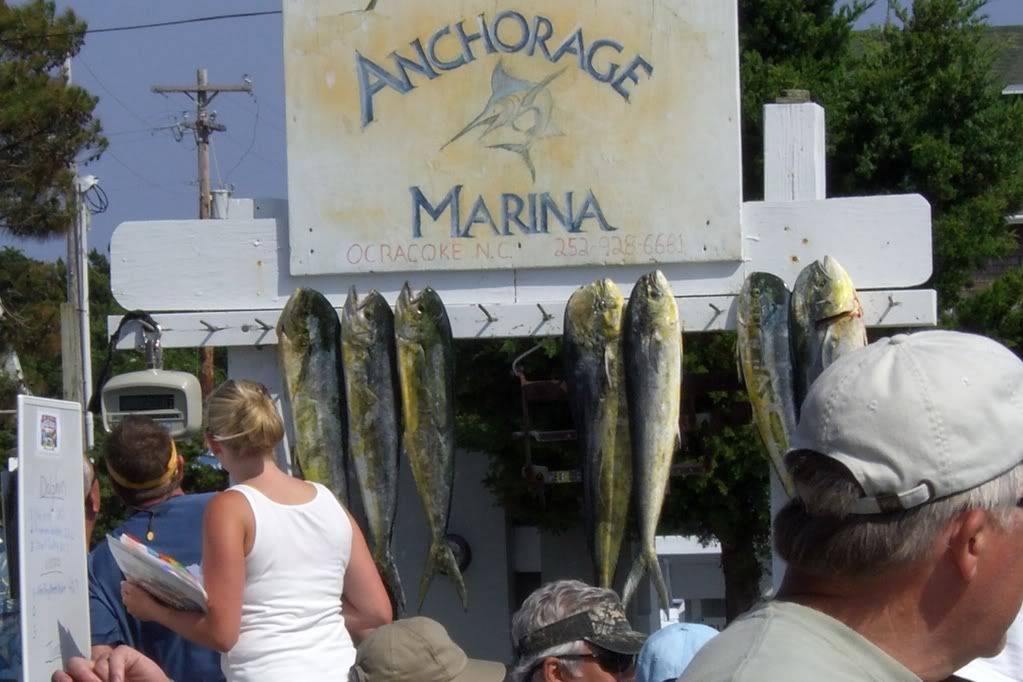 I'm not sure either has a real name, and one of them was for sale. They mostly accomodate campers who hang around for quite a while or leave their rigs there.
I'm not sure either has a real name, and one of them was for sale. They mostly accomodate campers who hang around for quite a while or leave their rigs there.The only thing I regret is not finding some flotsam. Our ghost tour guide said the locals really like to skim the beaches. Considering most of the wood for their houses came from shipwrecks I can understand why.
Our first day in Ocracoke, we went to the beach and looked around for anything that might be interesting. Ed found a piece of what must've been a ship. But we left it on the beach. You can find some really interesting things out there I'm sure, and it was a rough sea. I was hoping to find doubloons, but our ghost tour guide said that the area near the campground was the site of the wreck of the steam ship Home in which 90 people died. She said she didn't like to go to that beach because they buried the dead in the sand, and sometimes people found pieces of human bone there.
I don't know if any beach on the island could be considered ghost, or shipwreck free. It is one of the worst for them. But I think that's one of the things that make it worth visiting.
If you are heading north on your way home, don't forget to stop at the Graveyard of the Atlantic Museum. I wanted to but we didn't have time.

Next time, when we return. And I won't wait another 10 years. The island might be under water by then, or so they say, but for a sandbar, it's been around a long time. Maybe next time it will just be farther in to Pamlico Sound. Hopefully the old Pilot Town and Teach's Hole will still exist.
Tuesday, May 18, 2010
May is Motorcycle Awareness Month in Pa.
 Motorcycles are everywhere, and the Pennsylvania Department of Transportation wants drivers of other vehicles to realize that. Today they issued a press release encouraging drivers to pay attention to motorcyclists, check their blind spots for them and give motorcycles enough space on the road and not try to invade their space in a lane. PennDOT didn't mention scooters in this press release, but obviously it meant any two-wheeled, motorized, road-worthy vehicle.
Motorcycles are everywhere, and the Pennsylvania Department of Transportation wants drivers of other vehicles to realize that. Today they issued a press release encouraging drivers to pay attention to motorcyclists, check their blind spots for them and give motorcycles enough space on the road and not try to invade their space in a lane. PennDOT didn't mention scooters in this press release, but obviously it meant any two-wheeled, motorized, road-worthy vehicle.The reason for the release is that the weather (supposedly) is getting warmer, and that means motorcyclists are returning to the roads in force. Well, after getting back from a warm vacation I'm disputing the "getting warmer" reason, but it's true, motorcycles are going to be on the roads more often. And because many of those motorcyclists haven't been riding all winter, they're likely to be rusty and not as responsive and practiced in maneuvering their vehicles, at least until they get their initial practice in.
PennDOT is also concerned because there are more and more people signing up for motorcycle licenses. But to get a license all you have to do is pass a written test and a road course, and as all drivers can attest, it's really not that hard, or an accurate test of what could endanger you and the road and whether you can handle it.
PennDOT said there were 12,000 more people licensed to ride motorcycles, but only 3,000 more registered motorcycles. Does that mean the rest are riding unregistered motorcycles or have they been riding without a license all this time? (You can renew your learner's permit repeatedly in Pa., which means many riders may have some experience but never been properly taught how to handle their bike.)
Problem is, and I think PennDOT recognizes this but hasn't pushed for better licensing laws like Europe's graduated permits, there are thousands of people killed while riding motorcycles in the state each year. Just this week a former volunteer firefighter was killed on a highway near me while riding his motorcycle. Police said he crashed because he was going too fast, and though he was wearing a helmet, the force of him crashing into the guide rail threw it off his head. That's pretty fast.
I don't know what his riding experience was or if something caused him to crash, but he's one of several area motorcyclists who have been killed in this area this past weekend. Half the time it seems, at least to me as I write about these accidents, the fault is the cyclist, who couldn't handle their speed going around a curve, but the other half of the time a driver is to blame for not paying attention and cutting in front of the motorcyclist. It's one of the reasons I was so nervous, and still am, about riding on the roads around here. I realize I'm a novice, but the bigger fear is other drivers.
After I posted the brief on the Web site I work on, immediately drivers complained that PennDOT wasn't saying anything about the motorcyclists needing to be more attentive. But if drivers were more attentive to what they were doing overall, instead of goofing around, talking on their cell phones, texting, or even zoning out, then at least half the people who currently lose their lives when riding motorcycles (more if you consider how this would prevent accidents between cars and cars and cars and trucks) could be saved.
Motorcycles and scooters are always going to be dangerous for inexperienced riders, and you can't prevent every accident. Sometimes the elements just work against you, but training and awareness would reduce the danger for both motorcyclists and scooter riders. That isn't going to reduce the danger. Isn't that what everyone likes about motorcycle riding the danger. It's what makes it "bad." But that is turning out to bad for a lot of people who don't know what they are getting into.
Photo by Marc C. Psoras of the Lansdale Reporter
Monday, May 17, 2010
Are Asian scooters a dangerous thing?
According to a Sunday story in the Chicago Tribune
there is growing concern that the cheaply made scooters being shipped from China and elsewhere to satisfy consumer demand may be creating a safety issue.
Why? Because people see them as easy to ride when in fact they require the same knowledge and experience to properly operate as a motorcycle or full-sized scooter. Honestly, as someone who knows what it is like to be on a tiny vehicle on a major road next to a monstrous vehicle, there is nothing easy about it. According to the Tribune article, the problem is people think it is as easy to ride as a bicycle or car.
Nope! You move your body differently and have to understand how the vehicle's weight shifts affect its manueverability and management.
According to the article by Jon Hilkevitch, "But novice scooter drivers tend to have trouble keeping pace with traffic, making sure they are seen by other motorists, negotiating turns and handling emergency situations, safety experts say."
Cars don't see you, and unless you are conscious of this and know how to react because of the poor driving of others, you're screwed.
What does this all have to do with Asian scooters? Apparently because they are cheap and flooding the market, many more people who wouldn't normally buy one (because they are expensive and most people only shell out for one if they really want a scooter in particular) are doing so, and not realizing the importance of knowing what they are doing on it.
Now, I'm all for people riding scooters more often than cars. They use less gas, take up less space and reduce our consumption of oil. (Need to know why it is bad to consume lots of oil? Look at what that greed has done to the Gulf of Mexico.) I hate seeing people barreling down the road in a vehicle that they drive too fast (because they don't realize how fast they are going in those cush mobiles) and there is no one in the car and no reason for its massiveness other than status or ego.
Get on a scooter and you have to look at other people. You can hide behind tinted glass. In fact, you WANT them to see you. You want them to acknowledge you so they don't accidentally run you off the road.
Riding a scooter makes you friendlier. You wave to other scooter riders and motorcyclists because that is the norm. It also makes life seem a little better, and sweeter and less stressful. But that won't happen if you don't know what you are doing.
Want to get on a scooter? Lured by the cheapness? Take a free motorcycle riders class please. No one wants to hear of a scooter rider getting flattened.
there is growing concern that the cheaply made scooters being shipped from China and elsewhere to satisfy consumer demand may be creating a safety issue.
Why? Because people see them as easy to ride when in fact they require the same knowledge and experience to properly operate as a motorcycle or full-sized scooter. Honestly, as someone who knows what it is like to be on a tiny vehicle on a major road next to a monstrous vehicle, there is nothing easy about it. According to the Tribune article, the problem is people think it is as easy to ride as a bicycle or car.
Nope! You move your body differently and have to understand how the vehicle's weight shifts affect its manueverability and management.
According to the article by Jon Hilkevitch, "But novice scooter drivers tend to have trouble keeping pace with traffic, making sure they are seen by other motorists, negotiating turns and handling emergency situations, safety experts say."
Cars don't see you, and unless you are conscious of this and know how to react because of the poor driving of others, you're screwed.
What does this all have to do with Asian scooters? Apparently because they are cheap and flooding the market, many more people who wouldn't normally buy one (because they are expensive and most people only shell out for one if they really want a scooter in particular) are doing so, and not realizing the importance of knowing what they are doing on it.
Now, I'm all for people riding scooters more often than cars. They use less gas, take up less space and reduce our consumption of oil. (Need to know why it is bad to consume lots of oil? Look at what that greed has done to the Gulf of Mexico.) I hate seeing people barreling down the road in a vehicle that they drive too fast (because they don't realize how fast they are going in those cush mobiles) and there is no one in the car and no reason for its massiveness other than status or ego.
Get on a scooter and you have to look at other people. You can hide behind tinted glass. In fact, you WANT them to see you. You want them to acknowledge you so they don't accidentally run you off the road.
Riding a scooter makes you friendlier. You wave to other scooter riders and motorcyclists because that is the norm. It also makes life seem a little better, and sweeter and less stressful. But that won't happen if you don't know what you are doing.
Want to get on a scooter? Lured by the cheapness? Take a free motorcycle riders class please. No one wants to hear of a scooter rider getting flattened.
Subscribe to:
Posts (Atom)
